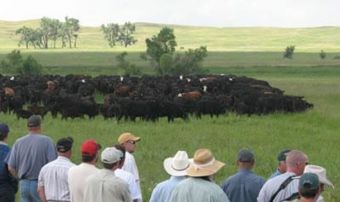Food/Sustainable ranching

Herbivores in the wild huddle close together for protection from predators. In this 'mob', they mow down an area of grass in about a day, then move on to a different patch. Ranches can be managed so that the livestock graze in this pattern. Using light, portable electric fencing, livestock can be corralled into a small 'cell' of grass at very high densities. Each day, the herd is moved to a different 'cell' of grass, so that each cell of grass is only grazed a few days per year.
The effects of this sort of grazing are remarkable, both for the grasslands and the animals. The manure fertilizes the grass, the mowing causes the grass to shed some of its roots, which then decompose and further improve the soil, and the animals' hooves break up the hardpan on the surface, further improving the structure of the soil. See water-efficient agriculture for how effective this is at helping soil hold moisture. This is particularly needed in sub-Saharan Africa, where extensive grazing patterns have made grasslands dry and dead. In areas of sub-Saharan Africa where cell-grazing has been implemented, grasslands have recovered and the soil and ecosystem holds so much water that drought is no longer a threat[3].
Another key advantage is that multiple animals can graze the same pasture in rotation. Polyface Farms grazes cows, turkeys, pigs, chickens, hens and rabbits on the same space by rotating them in time. This further benefits the soil and allows the animals to benefit from one another. For example, the maggots that grow in cow manure are a food source for chickens. Moreover, it obviously allows much higher productivity per unit of land.